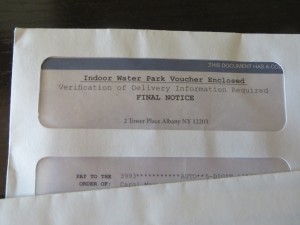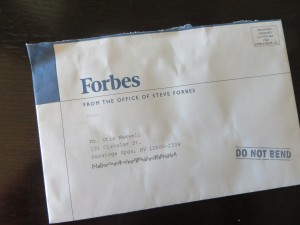The best scams and con games involve an element of human greed: that wealthy banker in Nigeria who made you his heir because of an incident you don’t remember, and may actually involve someone else; the check that reaches you by accident yet has your name on it and is perfectly legal tender. In the more adept scams, the next step usually is to tap into your bank account. In direct mail, it would typically be a subscription or sale of some kind.

In our more cynical age these tactics may not work as well, and I don’t see them as often. But they show up every now and then, like embers of a dying fire that flicker back to life. This “fake check” example charmed me with its absurdity: Indoor Water Park Voucher Enclosed/Verification of Delivery Information Required/FINAL NOTICE. Wow, that’s a lot of security to deliver what looks like a discount to an amusement park. But I did open it and it turns out it’s a timeshare offer, which happens to include admission to the water park. And if this isn’t enough, there’s a kicker: “our records indicate that by responding within 48 hours you will also receive a $100 Restaurant dining card”. I am almost tempted to take advantage of this offer to see what kind of person responds. Almost.
It’s easy to poke fun at the individual who would be lured into buying a money-sink timeshare purchase by the offer of a free ride on a water slide. But what about the distinguished prospect for Forbes, a respected business magazine? Would they really be motivated by that violator lower right on the envelope that says DO NOT BEND?

The target for this tactic was, traditionally, somebody who isn’t used to getting a lot of respect. The reason the package says “do not bend” is that a photo is inside (or sometimes a computer punch card, or a certificate of some kind). Wow, I’m so important that Steve Forbes, president of Forbes, is sending me a photo. But the funny thing is there isn’t any photo, or anything else which would be harmed in any way if you folded this mailer in half and stuffed it in your pocket.
Forbes is using a mass-production format and so you can bet they’ve done plenty of testing, and from that they’ve found out that hinting at an enclosed photo, then not providing the photo, is a great way to save some money without reducing response. In other words, it works, or they wouldn’t be doing it.
It’s humbling that such mailers are effective, and especially humbling that my household was deemed a ripe enough target to receive them. Maybe I should pack my bags for that 3 Days and 2 Nights including Water Park Passes for 4 guests, after all.
The best scams and con games involve an element of human greed: that wealthy banker in Nigeria who made you his heir because of an incident you don’t remember, and may actually involve someone else; the check that reaches you by accident yet has your name on it and is perfectly legal tender. In the more adept scams, the next step usually is to tap into your bank account. In direct mail, it would typically be a subscription or sale of some kind.
Timeshare “fake check” offer
In our more cynical age these tactics may not work as well, and I don’t see them as often. But they show up every now and then, like embers of a dying fire that flicker back to life. This “fake check” example charmed me with its absurdity: Indoor Water Park Voucher Enclosed/Verification of Delivery Information Required/FINAL NOTICE. Wow, that’s a lot of security to deliver what looks like a discount to an amusement park. But I did open it and it turns out it’s a timeshare offer, which happens to include admission to the water park. And if this isn’t enough, there’s a kicker: “our records indicate that by responding within 48 hours you will also receive a $100 Restaurant dining card”. I am almost tempted to take advantage of this offer to see what kind of person responds. Almost.
It’s easy to poke fun at the individual who would be lured into buying a money-sink timeshare purchase by the offer of a free ride on a water slide. But what about the distinguished prospect for Forbes, a respected business magazine? Would they really be motivated by that violator lower right on the envelope that says DO NOT BEND?
Forbes “DO NOT BEND” offer
The target for this tactic was, traditionally, somebody who isn’t used to getting a lot of respect. The reason the package says “do not bend” is that a photo is inside (or sometimes a computer punch card, or a certificate of some kind). Wow, I’m so important that Steve Forbes, president of Forbes, is sending me a photo. But the funny thing is there isn’t any photo, or anything else which would be harmed in any way if you folded this mailer in half and stuffed it in your pocket.
Forbes is using a mass-production format and so you can bet they’ve done plenty of testing, and from that they’ve found out that hinting at an enclosed photo, then not providing the photo, is a great way to save some money without reducing response. In other words, it works, or they wouldn’t be doing it.
It’s humbling that such mailers are effective, and especially humbling that my household was deemed a ripe enough target to receive them. Maybe I should pack my bags for that 3 Days and 2 Nights including Water Park Passes for 4 guests, after all.